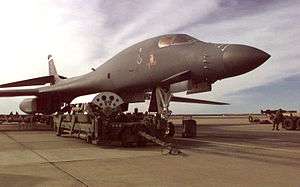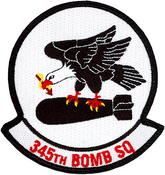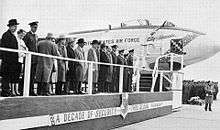345th Bomb Squadron
345th Bomb Squadron
 | |
|---|---|
 | |
| Active | 1942-1946; 1947–1966; 2015–present |
| Country |
|
| Branch |
|
| Role | Bomber |
| Part of | Air Force Reserve Command |
| Insignia | |
| 345th Bomb Sq emblem (approved 7 December 1956)[1] |
 |
| Patch with early 345th Bombardmenbt Squadron emblem |
 |
The 345th Bomb Squadron is a United States Air Force Reserve squadron, assigned to the 489th Bomb Group. It is stationed at Dyess Air Force Base, Texas, where it is an associate unit of the 7th Bomb Wing.
The squadron was first activated during World War II as the 345th Bombardment Squadron. It saw combat in the Mediterranean Theater of Operations, participating in the low level attack on oil refineries near Ploiești, Romania. It earned two Distinguished Unit Citations for its combat operations. After VE Day the squadron returned to the United States and trained with Boeing B-29 Superfortresses until inactivating in Spring 1946.
The squadron was reactivated in 1947 with Superfortresses. During the Korean War, it deployed to Japan and earned another Distinguished Unit Citation for its combat operations. The squadron returned to the United States and converted to the Boeing B-47 Stratojet, which if flew until inactivating in 1966 when the B-47 was withdrawn from service and Lincoln Air Force Base closed.
History
World War II
Training in the United States
![]() Media related to 98th Bombardment Group at Wikimedia Commons
Media related to 98th Bombardment Group at Wikimedia Commons
The squadron was first activated at MacDill Field, Florida as one of the original three squadrons assigned to the 98th Bombardment Group. The 345th soon moved to Barksdale Field, Louisiana, where it began to train as a Consolidated B-24 Liberator heavy bomber squadron under Third Air Force.[1][2]
The squadron's training was short and it deployed to Egypt in July 1942[1] over the South Atlantic Ferrying Route transiting from Morrison Field, Florida though the Caribbean Sea to Brazil. It made the Atlantic crossing from Brazil to Liberia, then transited east across central Africa to Sudan. The air echelon of the group reformed with the ground echelon which traveled by the SS Pasteur around the Cape of Good Hope, joining with the air echelon of the squadron and the 415th Bombardment Squadron at RAF Ramat David, in Palestine.[3]
Combat in the Middle East
Upon arrival in the Near East, the squadron became part of United States Army Middle East Air Force, which was replaced by Ninth Air Force in November. It entered combat in August, attacking shipping and harbor installations to cut Axis supply lines to North Africa. It also bombed airfields and rail transit lines in Sicily and mainland Italy. The squadron moved forward with Ninth Air Force to airfields in Egypt; Libya and Tunisia supporting the British Eighth Army in the Western Desert Campaign. Its support of this campaign earned the squadron the Distinguished Unit Citation.[1]

On 1 August 1943, the squadron participated in Operation Tidal Wave, the low-level raid on oil refineries near Ploiești, Romania. Alerted to the vulnerability of the Ploiești refineries by a June 1942 raid by the HALPRO project, the area around Ploiești had become one of the most heavily defended targets in Europe.[4] The squadron pressed its attack on the Asta Romana Refinery through smoke and fire from bombing by another group's earlier attack and heavy flak defenses. The squadron's actions in this engagement earned it a second Distinguished Unit Citation.[1]
When the forces driving East from Egypt and Libya met up with those moving westward from Algeria and Morocco in Tunisia in September 1943, Ninth Air Force was transferred to England to become the tactical air force for the invasion of the European Continent.[5] The squadron, along with all Army Air Forces units in North Africa became part of Twelfth Air Force. In November 1943, the squadron moved to Brindisi Airport, Italy, where it became part of Fifteenth Air Force, which assumed control of strategic operations in the Mediterranean Theater of Operations, while Twelfth became a tactical air force.[2][6]
Strategic operations in Italy
The squadron continued strategic bombardment raids on targets in Occupied France, southern Germany, Czechoslovakia, Hungary, Austria and targets in the Balkans. These included industrial sites, airfields, harbors and lines of communication. Although focusing on strategic bombing, the squadron was sometimes diverted to tactical operations, supporting Operation Shingle, the landings at Anzio and the Battle of Monte Cassino. In the summer of 1944, the squadron supported Operation Dragoon, the invasion of southern France.[2] The unit also asssisted the Soviet advance into the Balkans,[2] and supported Yugoslav Partisans and guerillas in neighboring countries.
Return to the United States
The squadron returned to the United States in May 1945. Upon arrival it was redesignated as a very heavy Boeing B-29 Superfortress squadron and began training for deployment to the Pacific to conduct strategic bombardment raids on Japan. In November 1945, the 98th Group was inactivated and the squadron moved to MacDill Field, Florida, where it was assigned to the 462d Bombardment Group. B-29 training continued until the unit was inactivated in July 1946.[1]
Strategic Air Command
Reactivation
![]() Media related to 98th Bombardment Wing at Wikimedia Commons
Media related to 98th Bombardment Wing at Wikimedia Commons
The squadron was reactivated in 1947 as a Strategic Air Command (SAC) Superfortress unit at Spokane Army Air Field, Washington. The squadron performed strategic bombardment training missions until the outbreak of the Korean War.[1]
Korean War
_attacking_target_in_Korea_1951.jpg)
In the summer of 1950, when the Korean War began, the 19th Bombardment Wing was the only medium bomber unit available for combat in the Pacific. In August, SAC dispatched the squadron and other elements of the 98th Bombardment Group to Yokota Air Base, Japan to augment FEAF Bomber Command, Provisional. The group flew its first combat mission on 7 August against marshalling yards near Pyongyang, capital of North Korea. The squadron's missions focused on interdiction of enemy lines of communications, attacking rail lines, bridges and roads. The squadron also flew missions that supported United Nations ground forces.[1][7]
SAC’s mobilization for the Korean War highlighted that SAC wing commanders were not sufficiently focused on combat operations. Under a plan implemented for most wings in February 1951 and finalized in June 1952, the wing commander focused primarily on the combat units and the maintenance necessary to support combat aircraft by having the combat and maintenance squadrons report directly to the wing and eliminating the intermediate group structures.[8] This reorganization was implemented in April 1951 for the 98th Wing, when wing headquarters moved on paper to Japan, taking over the personnel and functions of the 98th Group, which became a paper organization, and the squadron began operating under wing control.[9]
Starting in January 1952, the threat posed by enemy interceptors forced the squadron to fly only night missions. The unit flew its last mission, a propaganda leaflet drop, on the last day before the armistice was signed.[10] The squadron remained in combat ready status in Japan until July 1954 when it moved to Lincoln Air Force Base, Nebraska.[1][9]
Conversion to jet bombers

The squadron disposed of its B-29s to storage at Davis-Monthan Air Force Base, Arizona. At Lincoln, the squadron was equipped with new Boeing B-47E Stratojets. it engaged in strategic bombardment training with the B-47 throughout the rest of the 1950s, into the early 1960s. From November 1955 through January 1966, the squadron deployed to RAF Lakenheath as part of Operation Reflex, standing alert at the forward deployment site.[1]
From 1958, the 345th began to assume an alert posture at its home base, reducing the amount of time spent on alert at overseas bases to meet General Thomas S. Power’s initial goal of maintaining one third of SAC’s planes on fifteen minute ground alert, fully fueled and ready for combat to reduce vulnerability to a Soviet missile strike.[11] The alert commitment was increased to half the squadron's aircraft in 1962.[12]
Cuban Missile Crisis
Soon after detection of Soviet missiles in Cuba, on 22 October 1962 the squadron's B-47s dispersed.[13] On 24 October the 343d went to DEFCON 2, placing all its aircraft on alert. Most dispersal bases were civilian airfields with AF Reserve or Air National Guard units. The unit's B-47s were configured for execution of the Emergency War Order as soon as possible after dispersing. On 15 November 1/6 of the squadron's dispersed B-47s were recalled to Lincoln.[14] The remaining B-47s and their supporting tankers were recalled on 24 November. On 27 November SAC returned its bomber units to normal alert posture.[15]
The squadron was inactivated in June 1966 with the phaseout of the B-47 and closure of Lincoln.
Air Force reserve
In October 2015, the squadron, now named the 345th Bomb Squadron was activated at Dyess Air Force Base, Texas as an associate. The squadron operates and maintains the Rockwell B-1 Lancers assigned to the 7th Bomb Wing at Dyess.[16]
Lineage
- Constituted 345th Bombardment Squadron (Heavy) on 28 January 1942
- Activated on 3 February 1942
- Redesignated 345th Bombardment Squadron, Heavy on 1 July 1943
- Redesignated 345th Bombardment Squadron, Very Heavy on 23 May 1945
- Inactivated on 27 March 1946
- Activated on 1 July 1947
- Redesignated 345th Bombardment Squadron, Medium on 28 May 1948[17]
- Inactivated on 25 June 1966
- Redesignated 345th Bomb Squadron
- Activated on 17 October 2015[16]
Assignments
- 98th Bombardment Group, 3 February 1942
- 462d Bombardment Group, 10 November 1945 – 27 March 1946
- 98th Bombardment Group, 1 July 1947 (attached to 98th Bombardment Wing after 1 April 1951)
- 98th Bombardment Wing (later 98th Strategic Aerospace Wing), 16 June 1952 – 25 June 1966[17]
- 489th Bomb Group, 17 October 2015 - present[16]
Stations
|
|
Aircraft
- Consolidateed B-24 Liberator, 1942–1945
- Boeing B-29 Superfortress, 1945; 1947–1954
- Boeing B-47 Stratojet, 1954–1966[17]
- Rockwell B-1 Lancer, 2015-present[16]
References
- Notes
- 1 2 3 4 5 6 7 8 9 10 Maurer, Combat Squadrons, pp. 428-429
- 1 2 3 4 Maurer, Combat Units, pp. 169-170
- ↑ Rogers, pp. 77-78
- ↑ Schultz, pp.64-65
- ↑ Maurer, Combat Units, p. 464
- ↑ Maurer, Combat Units, pp. 467, 470
- ↑ Endicott, p. 74
- ↑ Deaile, pp. 175-176
- 1 2 Ravenstein, pp. 138-141
- ↑ Endicott, p. 75
- ↑ Schake, p. 220 (note 43)
- ↑ "Abstract (Unclassified), History of the Strategic Bomber since 1945 (Top Secret, downgraded to Secret)". Air Force History Index. 1 April 1975. Retrieved March 4, 2014.
- ↑ Kipp, et al., pp. 34-35. 49
- ↑ Kipp, et al., p. 53
- ↑ Kipp, et al., p. 61
- 1 2 3 4 5 Staff writer(s); no by-line (October 13, 2015). "489th Bomb Group reactivates". Shreveport Times. Retrieved October 19, 2015.
- 1 2 3 4 Lineage, including assignments, stations and aircraft, through 1963 in Maurer, Combat Squadrons, pp. 428-429
Bibliography
![]() This article incorporates public domain material from the Air Force Historical Research Agency website http://www.afhra.af.mil/.
This article incorporates public domain material from the Air Force Historical Research Agency website http://www.afhra.af.mil/.
- Deaile, Melvin G. (2007). The SAC Mentality: The Origins of Organizational Culture in Strategic Air Command 1946-1962. Chapel Hill, NC: University of North Carolina. Retrieved February 14, 2015.
- Endicott, Judy G., ed. (2001). The USAF in Korea, Campaigns, Units and Stations 1950-1953 (PDF). Maxwell AFB, AL: Air Force Historical Research Agency. ISBN 0-16-050901-7. Retrieved December 17, 2016.
- Kipp, Robert; Peake, Lynn; Wolk, Herman. "Strategic Air Command Operations in the Cuban Crisis of 1962, SAC Historical Study No. 90 (Top Secret NOFORN, FRD, redacted and declassified)". Strategic Air Command.
- Maurer, Maurer, ed. (1983) [1961]. Air Force Combat Units of World War II (PDF) (reprint ed.). Washington, DC: Office of Air Force History. ISBN 0-912799-02-1. LCCN 61060979.
- Maurer, Maurer, ed. (1982) [1969]. Combat Squadrons of the Air Force, World War II (PDF) (reprint ed.). Washington, DC: Office of Air Force History. ISBN 0-405-12194-6. LCCN 70605402. OCLC 72556.
- Ravenstein, Charles A. (1984). Air Force Combat Wings, Lineage & Honors Histories 1947-1977 (PDF). Washington, DC: Office of Air Force History. ISBN 0-912799-12-9.
- Rogers, Edith (June 1945). "The AAF in the Middle East: A Study of the Origins of the Ninth Air Force, USAF Historical Study No. 108" (PDF). Assistant Chief of Air Staff Intelligence, Historical Division. Retrieved May 25, 2017.
- Schake, Col Kurt W. (1998). Strategic Frontier: American Bomber Bases Overseas, 1950-1960 (PDF). Trondheim, Norway: Norwegian University of Science and Technology. ISBN 978-8277650241. Retrieved July 27, 2015.
- Schultz, Duane (2008). Into the Fire: Ploesti, the Most Fateful Battle of World War II. Yardley, PA: Westholme Publishing. ISBN 978-1594160776.